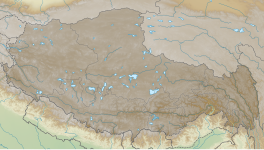Angsi Glacier
| Angsi | |
|---|---|
| Nangser | |
| Type | Valley glacier |
| Location | Tibel |
| Coordinates | 30°20′53″N 82°2′41″E / 30.34806°N 82.04472°E |
| Lowest elevation | 5319.7[1] |
 | |
| Angsi Glacier | |||
|---|---|---|---|
| Simplified Chinese | 昂色冰川 | ||
| |||
The Angsi Glacier or Nangser Glacier (Tibetan: ངང་སེར་འཁྱགས་རོམ, Wylie: ngang ser 'khyags rom, THL: ngang ser khyak rom) is a glacier located on the northern side of the Himalayas in the Purang County in China's Tibet Autonomous Region.[1] It is immediately to the east of the Indus-Tsangpo water divide at the eastern edge of the Purang County. One of the headwaters of the Tsangpo River (Brahmaputra), called Angsi Chu or Nangser Chu, originates in this glacier. Angsi Chu merges with the Chema-yungdung Chu[a] within a short distance (30°24′14″N 82°16′37″E / 30.4038°N 82.277°E), and the combined river is called Chema-yungdung Chu.[2]
Swami Pranavananda, an Indian ascetic and pilgrim, noted in 1939 that the Tibetan traditions regard the Chema-yungdung glacier as the source of Brahmaputra.[3] He also noted that Kubi Chu, another source stream of Brahmaputra favoured by Sven Hedin, is larger, and that the Angsi Chu gives greater length.[4]
As another complication, Angsi Chu merges with another stream called Dangkar Chu flowing from the Tumulung Lake (Tibetan: ཏུང་ལུང་མཚོ, Wylie: tung lung mtsho) before its confluence with Chema-yundung Chu (30°25′29″N 82°11′06″E / 30.4246°N 82.1851°E). Pranavananda also noted that the Indian Bhotiya merchants call the Tumulung Lake as "Brahmakund" and regard it as the source of Brahmaputra.[5] Water residues seen in satellite maps indicate that waters from the Ganglung Glacier, to the west of Angsi Glacier, once flowed into the Tumulung Lake, but now they flow west into Sutlej (30°26′25″N 82°00′19″E / 30.4402°N 82.0052°E).
In 2011, Chinese scientists from the Chinese Academy of Sciences declared that the Angsi Glacier is the "true source" of the Tsangpo River and this determination has been accepted by the Indian observers.[6][7] Encyclopedia Britannica continues to regard the Chema-yungdung Glacier as the source of Brahmaputra.[8]
Notes[edit]
References[edit]
- ^ a b Ganesh Pangare; Bushra Nishat; Xiawei Liao; Halla Maher Qaddumi, eds. (2021), The Restless River, Washington DC: World Bank, p. 32
- ^ "Geographical names of Tibet AR (China): Tibet Autonomous Region". KNAB Place Name Database. Institute of the Estonian Language. 2018-06-03. Gyaimayangzom.
- ^ "Scientists pinpoint sources of four major international rivers". Xinhua News Agency. 22 August 2011. Archived from the original on December 30, 2013.
- ^ Krishnan, Ananth (23 August 2011). "China maps Brahmaputra, Indus". The Hindu. Archived from the original on 6 August 2018.
- ^ Brahmaputra River, Encyclopedia Britannica, retrieved 3 October 2022. "The Brahmaputra’s source is the Chemayungdung Glacier, which covers the slopes of the Himalayas about 60 miles (100 km) southeast of Lake Mapam in southwestern Tibet."
Bibliography[edit]
- Pranavananda, Swami (1939), Exploration in Tibet, University of Calcutta – via archive.org
External links[edit]
- Dangkar Chu (with Angsi Chu as a tributary), OpenStreetMap, retrieved 3 October 2022.

